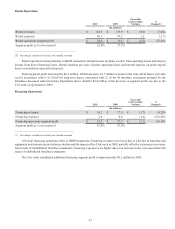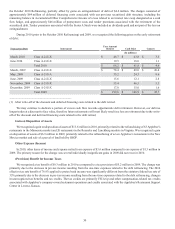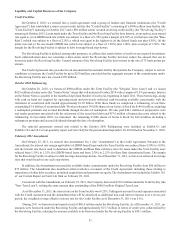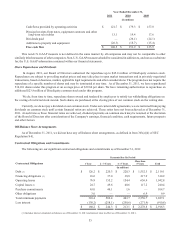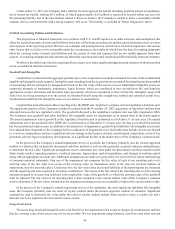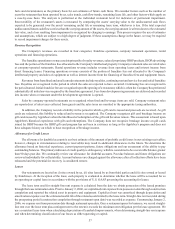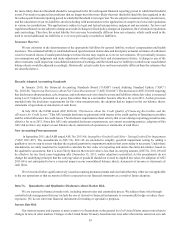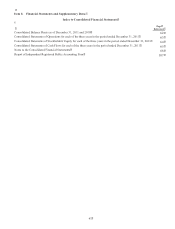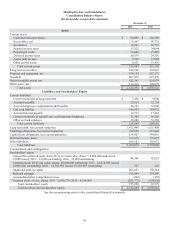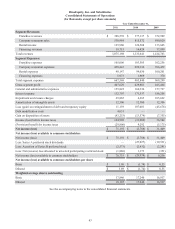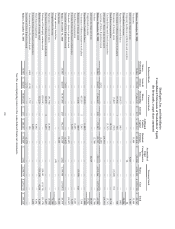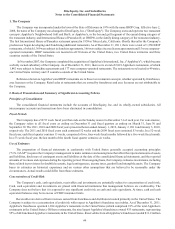IHOP 2011 Annual Report Download - page 75
Download and view the complete annual report
Please find page 75 of the 2011 IHOP annual report below. You can navigate through the pages in the report by either clicking on the pages listed below, or by using the keyword search tool below to find specific information within the annual report.57
facts and circumstances as the primary basis for our estimates of future cash flows. We consider factors such as the number of
years the restaurant has been operated by us, sales trends, cash flow trends, remaining lease life, and other factors which apply on
a case-by-case basis. The analysis is performed at the individual restaurant level for indicators of permanent impairment.
Recoverability of the restaurant's assets is measured by comparing the assets' carrying value to the undiscounted cash flows
expected to be generated over the assets' remaining useful life or remaining lease term, whichever is less. If the total expected
undiscounted future cash flows are less than the carrying amount of the assets, the carrying amount is written down to the estimated
fair value, and a loss resulting from impairment is recognized by charging to earnings. This process requires the use of estimates
and assumptions, which are subject to a high degree of judgment. If these assumptions change in the future, we may be required
to record impairment charges for these assets.
Revenue Recognition
The Company's revenues are recorded in four categories: franchise operations, company restaurant operations, rental
operations and financing operations.
The franchise operations revenue consists primarily of royalty revenues, sales of proprietary IHOP products, IHOP advertising
fees and the portion of the franchise fees allocated to the Company's intellectual property. Company restaurant sales are retail sales
at company-operated restaurants. Rental operations revenue includes revenue from operating leases and interest income from
direct financing leases. Financing operations revenue consists of the portion of franchise fees not allocated to the Company's
intellectual property and sales of equipment as well as interest income from the financing of franchise fees and equipment leases.
Revenues from franchised and area licensed restaurants include royalties, continuing rent and service fees and initial franchise
fees. Royalties are recognized in the period in which the sales are reported to have occurred. Continuing fees are recognized in
the period earned. Initial franchise fees are recognized upon the opening of a restaurant, which is when the Company has performed
substantially all initial services required by the franchise agreement. Fees from development agreements are deferred and recorded
into income when a restaurant under the development agreement is opened.
Sales by company-operated restaurants are recognized when food and beverage items are sold. Company restaurant sales
are reported net of sales taxes collected from guests and the sales taxes are remitted to the appropriate taxing authorities.
In addition, the Company records a liability in the period in which a gift card is issued and proceeds are received. As gift
cards are redeemed, this liability is reduced and revenue is recognized. The Company recognizes gift card breakage income on
gift cards issued by Applebee's when the likelihood of redemption of the gift card becomes remote. This assessment is based upon
Applebee's historical experience with gift card redemptions. The Company does not recognize breakage income on gift cards
issued by IHOP because the IHOP gift card program has not been in existence as long as the Applebee's program and does not
have adequate history on which to base recognition of breakage income.
Allowance for Credit Losses
The allowance for doubtful accounts is our best estimate of the amount of probable credit losses in our existing receivables;
however, changes in circumstances relating to receivables may result in additional allowances in the future. We determine the
allowance based on historical experience, current payment patterns, future obligations and our assessment of the ability to pay
outstanding balances. The primary indicator of credit quality is delinquency, which is considered to be a receivable balance greater
than 90 days past due. We continually review our allowance for doubtful accounts. Past due balances and future obligations are
reviewed individually for collectability. Account balances are charged against the allowance after all collection efforts have been
exhausted and the potential for recovery is considered remote.
Leases
Our restaurants are located on (i) sites owned by us, (ii) sites leased by us from third parties and (iii) sites owned or leased
by franchisees. At the inception of the lease, each property is evaluated to determine whether the lease will be accounted for as
an operating or capital lease in accordance with the provisions of U.S. GAAP governing the accounting for leases.
The lease term used for straight-line rent expense is calculated from the date we obtain possession of the leased premises
through the lease termination date. Prior to January 2, 2006, we capitalized rent expense from possession date through construction
completion and reported the related asset in property and equipment. Capitalized rent was amortized through depreciation and
amortization expense over the estimated useful life of the related assets limited to the lease term. Straight-line rent recorded during
the preopening period (construction completion through restaurant open date) was recorded as expense. Commencing January 2,
2006, we expense rent from possession date through restaurant open date. Once a restaurant opens for business, we record straight-
line rent over the lease term plus contingent rent to the extent it exceeds the minimum rent obligation per the lease agreement. We
use a consistent lease term when calculating depreciation of leasehold improvements, when determining straight-line rent expense
and when determining classification of our leases as either operating or capital.


